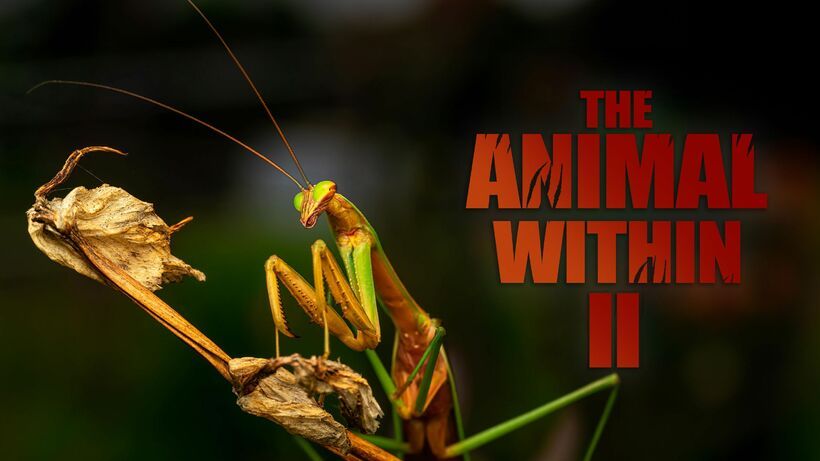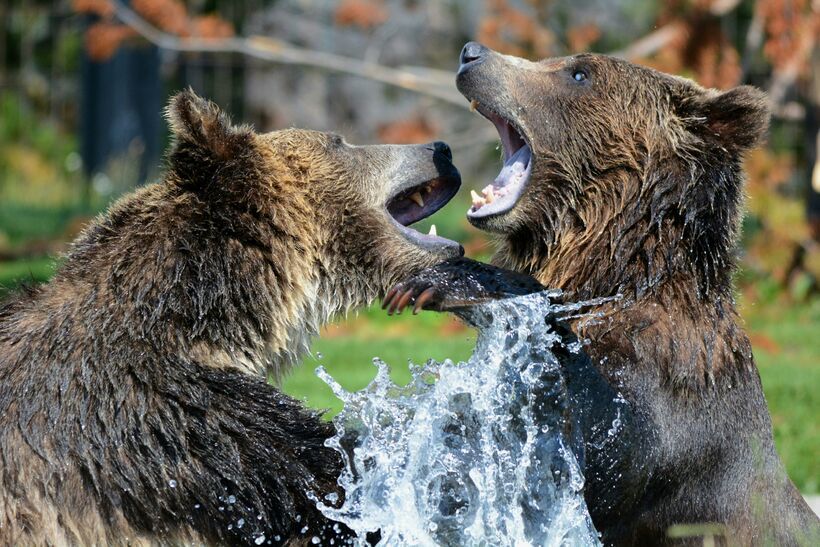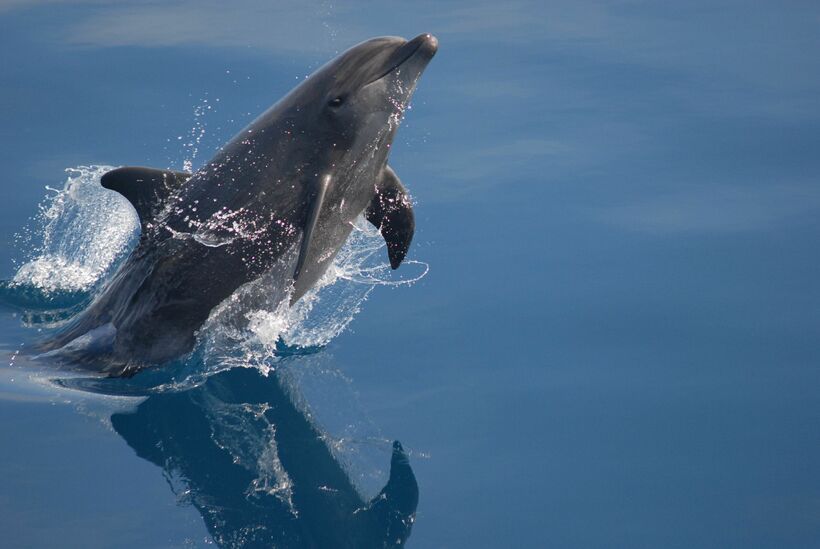The Animal Within 2
Though science strives to build perfect machines, none are more finely calibrated than the ones that survive, endure, fight, and thrive in the natural world.
Under the hoods of majestic beasts, the specs are too impressive to be invented. Physiological features allow creatures to adapt, endure, target prey, collaborate, put up a valiant defense, and move as if invisible. How does the raven’s voicebox allow it to emit noise bilaterally? On the savannahs of sub-Saharan Africa, the hyena uses its jaw like a vice grip, crushing bones effortlessly with the power of physics. When the long-eared owl hunts, it soars overheard soundlessly. In the barren wilderness, the transparent fur of the lonely polar bear inspires the next generation of warm weather gear. From the tiny jerboa who braves extreme temperature swings, to one of the most poisonous creatures on earth -- the poison dart frog -- ready to excrete its toxic serum. The hidden blueprints of the animal kingdom provide a glimpse of engineering at its finest. Each elegant machine forged of flesh and blood has been meticulously conceived to survive and flourish in the wild.
The Animal Within 1
Episodes
-
The Master Hunters
With designs upon their prey, master hunters of the animal world go in for the kill. Every year, grizzly bears capitalize on the salmon spawning season, catching fish as they swim upstream. Their enlarged nasal mucosa helps them hone in on rivers and select the most calorie-laden fish. Their claws, 2 to 4 inches longer than those of most black bears, help them to catch and hold their prey, while their advanced digestive systems allow them to consume up to 100,000 calories per day in an effort to build up fat reserves. The bald eagle is the most versatile of hunters, using keen eyesight, a large wingspan, and razor-sharp talons to soar, spy, and target prey. They pair up when needed and also scavenge and steal from other creatures. For grey wolves, hunting is a team effort. Forms of silent communication and defined roles in the pack facilitate long chases, while the wolf’s extreme sensory abilities -- vision adaptations to detect small movements in the dark, a sense of smell 100 times more sensitive than humans, and special ear structures to enhance their hearing --turn wolves into advanced multi-modal prey detection arrays. When the praying mantis strikes, it strikes with precision. With a head that rotates up to 180 degrees, the praying mantis surveys the scene while lying in wait, then deploys its deadly spiked front legs to skewer its victims.
-
The Communicators
Some of the animal kingdom’s best communicators find ingenious ways to get their point across. The honey bee uses a distinctive waggle dance to reveal the direction, distance, and quality of food sources. Chemical pheromones, wing beat vibrations, and the sharing of food also serves to regulate colony behaviour. Bottle-nosed dolphins use whistles, clicks, and pulse sounds to perform sonar navigation, identify objects, and coordinate with other dolphins in the pod. Each dolphin has its own unique whistle identifier -- almost like a name. In one tenth of a second, prairie dogs can relay the species, size, colour, and speed of incoming threats. Each colony boasts its own dialect, and they use different frequency modulations made by their advanced vocal cords to emit calls and chirps to mark out and defend territory. The leaf-cutter ant has a special organ called the stridulatory organ: a biological mechanism not unlike a record player. When activated, a biological scraper rubs against a ridged surface, producing vibrations that alert others in the colony to food sources, danger, or the need for help. Paired with the ant’s use of pheromones and other behavioural signals, this remarkable adaptation makes the leaf-cutter ant an adept communicator.
-
The Endurance Champions
From deep-divers who hold their breath, to long-distance travellers and patient flyers, it takes a lot to tire out the endurance champions of the animal world. When diving under the surface, emperor penguins can reach depths of up to 1800 feet, holding their breath for a harrowing 22 minutes. As they dive, they lower their heart rates to conserve oxygen. Every year, the migratory generation of the monarch flies up to 3,000 miles to their overwintering sites in Mexico, relying on fat reserves to sustain them as they travel up to 100 miles per day. As prey animals, prong horned antelopes keep running long after their pursuers tire. Able to keep pace at speeds of up to 70 km/hour for incredible distances, prong horned antelopes are optimized for cardio with large hearts, lungs, and tracheas. Hollow hair keeps them light and nimble, while cushioned hooves absorb the running impact. For the lonely albatross, days and weeks spent at sea demand unusual endurance. Flying up to 10,000 miles without landing, the albatross utilises crosswinds and extracts energy from wind shear using a technique called dynamic soaring. Special glands allow them to drink seawater and some believe they can even sleep as they fly. In the arid climes of the desert, camels can plod along for up to 15 days without water. Capturing moisture from the air as they breathe, camels can cover up to 40km per day -- all while carrying loads of up to 200kg.
-
The Stealth Experts
Hiding in plain sight, these masters of disguise harness the power of invisibility. Special skin cells help the chameleon change its appearance and reveal this creature’s moods and stress levels. In the breeding season, colourful displays help males attract mates and challenge competitors. Up in the trees, stick insects emulate the branches and twigs that surround them. Plant pigments from their diets get sequestered into their exoskeletons, while countershading and gradients make their disguise more realistic. As the days get shorter, changes in daylight are registered by the pineal gland of the Arctic fox, prompting an important hormonal shift. On the edge of winter, they shed their brown, grey, and red coats for a thick white coat that will allow them to hide in the snow. When the long-eared owl takes flight, you won’t hear it coming. Its “fuzzy” feathers allow it to perform silent attacks. When it roosts, its speckled plumage fades into the bark of nearby trees to camouflage it from predators. To increase the effect, the owl “sucks in” its body and erects its ears, mimicking the vertical lines of wood grain.
-
The Survivors
In the most extreme conditions, the survivors of the animal kingdom adapt and thrive. Wood frogs re-animate, even after being frozen solid. Their livers produce a natural antifreeze glucose that protects cells during freezing and thawing. In some of the coldest places on earth, the polar bear goes on the hunt. Using layers of blubber and thick water-repellent fur, it rebuffs the cold in winter months, slowing down its metabolism when food is scarce. In the summer months, it enters a walking hibernation state in anticipation of the frigid weather that lies ahead. The ocean’s deep-sea thermal vents reach temperatures up to 400 degrees Celsius and spew toxic chemicals. In these adverse conditions, the Pompeii worm makes its home, using its protective armour (chitin) and haemoglobin-rich gills to survive the intense heat and toxicity. In the deserts of North Africa and Asia, temperatures range from near-freezing to over 54 degrees Celsius. To survive these extremes, the jerboa burrows under the sand to get away from the blazing Sun and extracts moisture from its food in warmer months. When the heat becomes too much, the jerboa can enter torpor, slowing its breathing and lowering its body temperature. In times of extreme cold, the jerboa’s body enters a state of hibernation. T he world’s northernmost dwelling primate is the Japanese macaque, a creature native to the Japanese Alps where temperatures drop as low as -30 degrees Celsius. In the Fall, the macaque grows a thick coat with soft downy layers. As an opportunistic omnivore, it loads up on fatty foods before the weather turns. To stay warm, it huddles together with other macaques for body heat and takes long baths in the Japanese hot springs.
-
The Warriors
When faced with danger, these armoured animals know how to take a blow -- and deliver some damage of their own. Wearing its rugged protective shield, the alligator snapping turtle is suited up to defend itself. Its shell (or carapace) is covered in horny scales and made of rock-hard osteoderms. Three ridges of sharp spikes threaten all who are brave enough to deliver a hit. If creatures get too close, the turtle uses its razor-sharp claws and 1,000 pounds of bite force to defend itself. When cornered, the dreaded cassowary is ready for a fight. Strong legs and 5-inch claws strike with punishing force as cassowaries charge, peck, and leap upon predators with their formidable jumping skills. In the fray, cassowaries are also protected by their helmet-like casque. Many curious pets have suffered the wrath of the porcupine -- a warrior armed with more than 30,000 detachable quills. At the end of each quill is a microscopic barb: a structure that lodges in the flesh of predators while also lending the quill a higher penetration force. Arrector pili muscles allow the porcupine to raise and direct its spikes. Lost quills grow back at a rate of up to 0.5mm per day. When an enemy approaches, the pangolin gets into position, curling up into a nearly-impenetrable ball. Enemies that choose to investigate find that the pangolin’s scales, unsheathed by this body position, are sharp enough to slice. A quick swipe of their sharp scaly tail inflicts further damage.
Facts
-
Original TitleThe Animal Within 2
-
YearRelease: December 2025
-
Length6 × 52' (ENG, GER)
-
ResolutionHD, 4K
-
Film byDaniel Oron
-
Produced by
-
Partners




